
Codebits conference Transcript
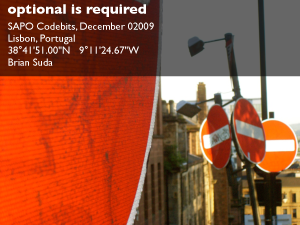
00:00 My name is Brian Suda and this has been an incredible conference so far, just the whole setup of this place is really, really amazing. I’m really enjoying it. So thanks for inviting me, hopefully I’ll inspire you with this talk and a few other things. The name of the talk is “Optional is required” and I think the organizers might have made a big mistake in letting me pick my own topic and my own talk, cause now I’ve kinda gone way off topic. So we’ll see how it ends-up.
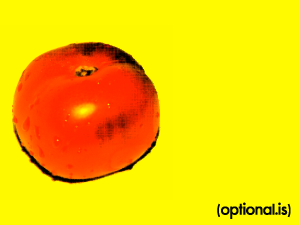
00:48 I choose the name “optional is required”. It came from a friend of mine and he just made some sort of off comment. He was talking about forms on a website. He said that every time you add another form on a website, 50% of your people just quit. So if you have something like email address is required, immediately you’ve lost 50% of your audience. If you say, OK, phone number is also required, you’ve lost another 50%. I don’t know if it is actually true, but it got me thinking. The only think that should be required is that everything is optional. It’s a little oxymoronic that Optional is the only thing that is required. It really stuck with me and I’ve kinda been in that mind set that I need to keep things optional. Today, I’m going to go through loads of crazy ideas and hopefully some of them will be a little oxymoronic and maybe some crazy ideas, but hopefully it will spark something in the next 24 hours when you’ve got your hacks and you’re working on projects.
So a little bit about myself. I am from the US originally, now I am living up in Iceland. Before I flew here it was about -3 degrees Centigrade and there was about 10 centimeters of snow on the ground and I show-up here and it is nice green weather and 17. I’ve had a 20 degree temperature swing and it is doing my head in. My background is officially in computer science software systems and informatics. So I have spent a lot of time coding and hacking and I’m well aware of how things work and agile development and all the other buzzwords. But most recently I’ve strayed away from actually writing code and more coming-up with lots and lots of crazy ideas and try to tell other people to write them and it doesn’t always work. Most recently, I’m sure you guys are all aware that Iceland has had a bit of an economic crunch. It is bankrupt, no one is sure yet, we own the UK and the Netherlands a lot of money, but strangely a year, year and a half ago, it was really, really hard to get people together, to talk to each other, ever since the crunch and people have lost their jobs people are coming out of the woodwork. I couldn’t figure out exactly why, but maybe it is because now times are so difficult, you have to be creative, you have to really think outside of the box just to survive. There is a great quote someone say, “Now, to be safe is risky, to be risky is safe.” and he is basically saying that now that the old school way of doing things where you invested a lot of time and money in one or two big projects is really, really risky. You are better off indulging you interest in 20 or 30 little projects that might be risky and one of those will pay off and do well.
So again, in Iceland now after the crunch everyone is looking for crazy, creative ideas. So we’ve had a really good time recently coming-up with some of these. I’m going to run some of them and maybe inspire you in the next 24 hours.
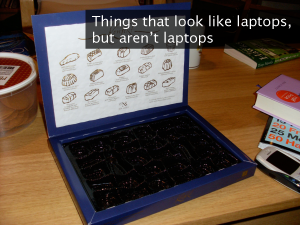
04:00 I started this flickr group, things that look like laptops, but aren’t actually laptops. I think i am the only person who has posted in it and it is just that picture. I love these sort of new perspectives and semantic discussions about things.
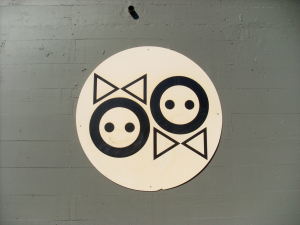
04:22 I saw this picture last year in Lisbon for SHIFT and it is brilliant because it is the exact same thing, but upside down. Can you image in the guy who has to hand this up, when he pulls it out of the back ... stick it up there.
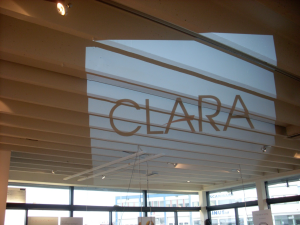
04:38 I work for a small company named CLARA and when moved into our new office space. The first thing we did was try to make this place really cool and fun. So we took a projector, just like the projectors here and shined it up on the ceiling with our logo and we decided that we’ll paint our corporate logo onto the ceiling so everyone knows which area of the building is ours.
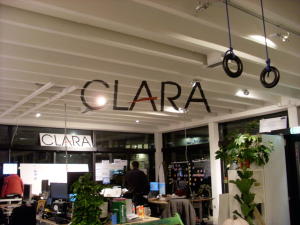
05:00 So when we did that we can up with a really cool effect. So when we painted on the ceiling you had to be in the exact right spot to see it. You have no idea how long we spent watching the mail man come in each morning and see where he would stop and were random people would coming and stop looking for office, so we put a little X on the floor and put the projector there.
This is what it looks like now, we penciled it in and then painted it. It looks really good.
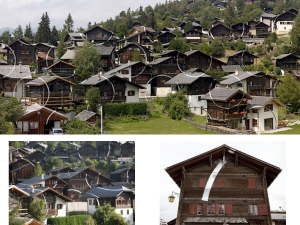
05:30 Then last month i found out there is a town in Switzerland that stole my idea. They painted the entire village with these rings. Again it is the same effect. When you are standing in this one spot in the village you can see this beautiful system, but in other places it is all broken up, half painted buildings and stuff like that. Again, it is a new perspective and there is a single point which is where you get the whole bigger picture.
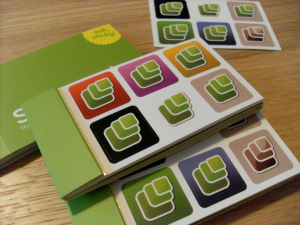
05:58 So i do a lot of work with Microformats. There are a couple of books out about microformats so I won’t go too much in depth about them. There is another talk tomorrow by Glenn about Microformats and identity and how to move all the information on the web together. And really what microformats do is add in additional semantics into your HTML, so people who do web development know there are probably 45-50 unique elements and these are things like DIVs and Paragraphs and headings. So there is a finite set of what is available. What microformats allow you to do is add additional information on top of that. So you might say, not only is this a paragraph, but this paragraph is about a person or this paragraph is about an event so it adds a lot more information. What it ends-up doing is convert a web of pages into a web of data. Google knows about 8 billion webpages, if each of those has a little bit of microformats in it, then you’ve got 8 billion databases that you can read from. So in the next 24 hours when you go away and do some of your hacks, if you are looking for this sort of scraping of information off the web or gathering and aggregating data, then microformats might be a really good source for extracting this information. So I’ll be around if anyone wants to talk about it.

07:18 This is something that I love, it is called Butterfly graffiti. In the US, as monarch butterflies migrate from [Mexico] across the US to Canada. To go back to their nesting grounds much like salmon go home when they want to breed. A lot of people said, oh butterflies are pretty, I would like them to stop-over in my backyard as they are migrating. So a lot of people who plant Flowers so that butterflies would stop and have something to eat along the way. Someone got the brilliant idea of, again this whole idea of semantics, a small flower is good, a big flower must be even better. So they started hanging gigantic flowers in their back gardens to try and attract the butterflies. The problem is that butterflies don’t see in the same color spectrum that we do. They are ultraviolet, UV light. So they will see these bright flowers, because they are organic and bouncing this bright UV light back, but the wall and the gigantic flower to them is solid grey, they don’t notice it. So what people started to do is cut out the big flower and start to cover it with hairspray or sun screen because that reflects UV light. So all of a sudden you’re a butterfly, flying along looking for food and you said, “oh there are some flowers and Holy crap there is a massive one over there!” It acts as a trick, they get there and they are disappointed, but it attracts the butterflies in. It is amazing to think about, the semantics on this level we can’t even see it, it isn’t in our visual spectrum. These are things that really get my head ticking over.
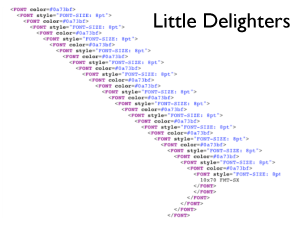
08:51 So I want to talk a little about these little delighters. As you guys go away and hack away on your code, maybe two or three people will be working on the same project and I was never the greatest coder in the world, so someone might make a better project than me, but these little delighters, these little easter eggs that you can sneak into your code. Everytime someone sees it, it makes them smile it makes them laugh and I would say that if two products were completely identical, but one had these little delighters in it, I might be more apt to use that one. Infact, the ones with the delighters might even be a worse product, but they make me smile and I really enjoy it.
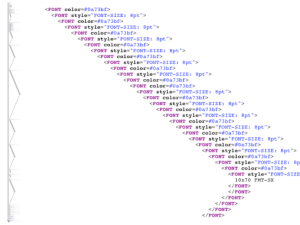
09:00
So I found this example, and I do a lot of HTML programming so I found this absolutely hilarious. Some guy has nested 25 or 30 font tags. They sent this around on some mailing lists and everyone was laughing at this guy, “ha ha, he doesn’t know how to program HTML”, “Is he using dreamweaver, look at that, it’s ridiculous!”. Then someone took the whole webpage and zoomed it out, and he’s done it like 6 or 7 times! This guy doesn’t know what he’s doing, this is ridiculous. And we were talking and everyone was laughing and well what kind of company is this, what do they do? Well, they sell binoculars and telescopes. And someone said, what if we turn that on its side? That looks kinda strange. What product did they make again? Ah, telescopes. Where were they located?

10:25 Oh, they’re in Japan. So someone got the brilliant idea to check it out on Google Maps or Google Earth. They said, where is their office? And they looked them up. And that was the picture and low and behold.
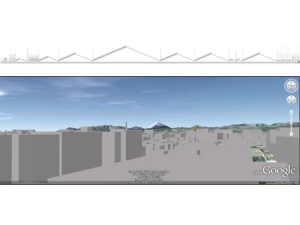
10:37 When they superimposed the HTML code it matched-up perfectly with all the mountains! So immediately, my first thought was. Let’s check out my office building!
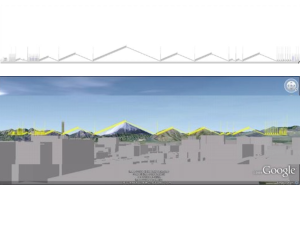
10:37 ???
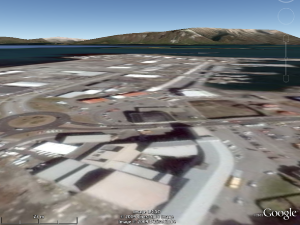
10:52 So this is where I work, and this is the mountains in the background.
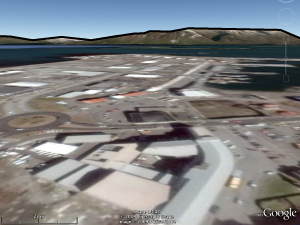
10:52 I went and traced them.
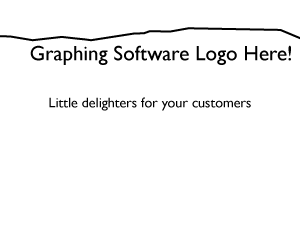
15:00 Voila, next time i make some graphing software I am going to put that little graph in the background! So feel free to steal that this week if you are using it. And again, it is these little delighters, most of your customers aren’t going to realize that, but maybe 6 months later or a year later, somebody is going to notice that and think that looks really familiar! It is like a double easter egg. It is like that guy who wrote that horrible code, because they found his easter egg, but he got the last laugh because it actually meant something. Brilliant Ideas.
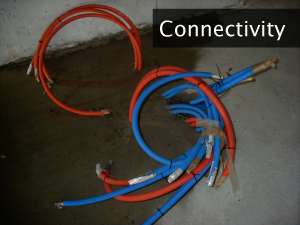
11:29 I want to talk a little bit about connectivity moving on from delighters.
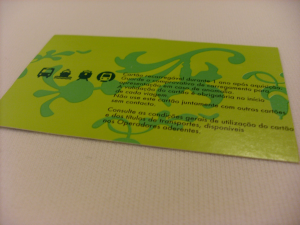
11:37 You guys have all probably seen this, this is your transit card it has a little RFID tag in it. RFID for those of you who may not know, works by having the chip which is basically a bunch of copper coils and when you put it over the RFID reader, the RFID reader is shooting some microwaves in and creates a loop and the card gives its ID out and the system can do something. In this case, it is debitting your account so that you have less credit. But you can do lots of things with the RFID.
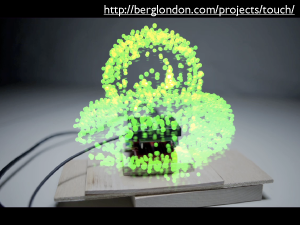
12:12 These guys from BERG London did some pretty heafy duty experiments, they have a video. If you haven't see it, I highly recommend it. What they did was a bit of stop motion photography. They took a picture of the RFID reader and kept the shutter open and had a little RFID chip and when the RFID reader and the ship come into contact the computer says, "Ok, what do you want me to do?". In this case, they said, light up a little LED light. So they ended-up probing all around the RFID reader and they found when the chip enters and when it can be read. It ends-up creating this really pretty structure. That is the sphere of influence. This is the area inwhich the RFID chip will be read. It all depends on the shape of the RFID chip, the angle which you come at it and the video is incredible because they do it all different angles and heights. The idea is that you can figure out the sphere of influence when you are checking into the metro system how far away or how close the chip needs to be.
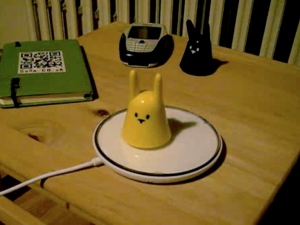
13:21 So a couple of years ago I was playing around with this idea and i've got the Violet company, they make a consumer ready RFID reader. So you get a big plate which is your RFID reader and they send you a couple rabbits and chips and stuff. Each of the little rabbits has an RFID chip in it. So I thought, "What can i do with this?".
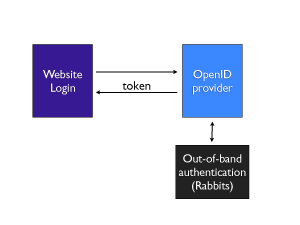
13:44 So what I decided to do was use my rabbits as a login system for an OpenId Provider. OpenId works by, you go to a website, and it says, "what is your OpenID URL", you type in your openId url. It brings you over to your OpenID provider, At that point your OpenID provider normally asks you for your name and password. If you get that right, it sends back to the orginal website with a token saying that Brian Suda is really who he claims to be he correctly typed in a name and password. But there is no reason why we can't do a different type of authentication. In this case, out-of-band authentication. Which is, out-of-band, off-the-website.
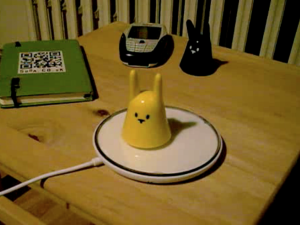
14:27 So what i decided to do was to when i typed in my OpenID URL, it sent me to my OpenId site which just sat there in an infinite loop and every couple of seconds it was checking my database. So when i went off to my openID provider, it said "Ok brian, your challenge is to put the yellow rabbit onto the RFID reader" and it was sitting there waiting for me. So i went around, found the yellow rabbit put it on the RFID reader, the RFID reader reads it, says "yeah, that's ok, that's the yellow rabbit" and inserts something into the database. And my website is sitting there looking, checking, checking and all of a sudden, "Hey, we've got a new entry" it is the same RFID as the yellow rabbit which I told him to put on there, it must be Brian who put that on there and then it would send a token back to the website. So it allowed for out-of-band authentication. It is really interesting things we can start doing with RFID hacking when we know the sphere of influence and interesting functionality.
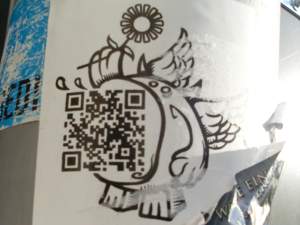
15:27 But we don't have to necessarily stop at RFID. These are 2D barcodes. I don't who is really familiar with those. How many people have seen these before? OK, most everybody. This one, the QR code style can handle up to 4000 characters. I found this one in berlin, i think if you take a picture of it, it says "I am good you are evil", something like that. It's abit of a weird one.
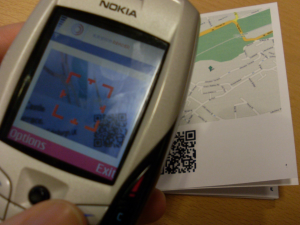
15:54 As you're well aware. You point your camera to it, it reads the QR code and then you can do anything. In many cases it is a URL and it can take you to a website. With RFID chips and QR codes we are starting to link physical objects, a piece of paper, cards, rabbits, and connecting it back with the web.
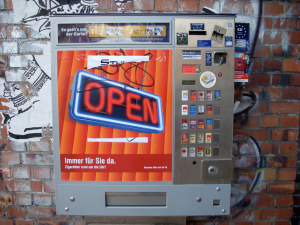
16:19 I want to talk to you here a little bit about 1 page web apps. Since alot of you guys will be doing hacks you don't need to take a big chunk and work on something really big. A lot of the stuff that I am working on is pretty much just one page. It is easy to do, easy to maintain. There was a quote somewhere that said. Don't think about if your company becomes successful, think about when it does. Is this a product that I want to be stuck with in a year if it becomes successful. And if your answer is no. You probably shouldn't really be working on it. So alot of these little one page apps, lets you test the water to see if things are worth doing.
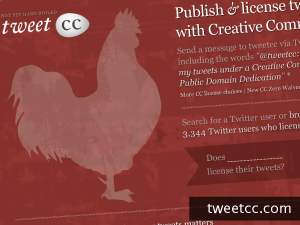
17:04 The first one I want to highlight is a website called TweetCC. Myself and Andy Clarke worked on this one and we used the Twitter API which is always a good source of information. IN doing so, I think twitter a year or so ago, everyone was questioning: can you copyright a tweet. What is the legality of all of that. We said, that we can trump all this and people can just dedicate their tweets to creative commons or attribution or public domain. How ever they wanted to do it. It works really easy, you just send a message to @tweetcc with a link to the particular license that you want. We just categorize it and just say, OK Brian Suda says YES, Remy says YES, so and so says YES and So and So is not in the database yet so we don't know. So we started to build this platform of people who are willing to open their twitter account. And in doing so we've basically built a platform, we didn't build a product, we didn't go out to build this huge monumental hack, just just have a list of people and which licenses they're willing to share the information.
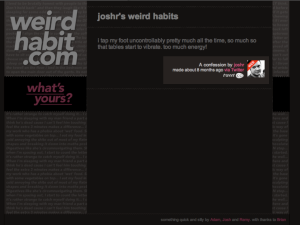
18:15 So other sites like weirdhabits, this is one that Remy was working on. It allows you to type in this weird habit. Josh says, "I tap my foot uncontrollably pretty much all the time". And in doing so, we've got josh's username. Weirdhabit just asks tweetcc, "Does Josh License his tweets?" We say, "yes he does". So theey stick an extra little icon in there. So we've managed to build this platform. So the think about this is that these one page websites can actually be quite prolific.
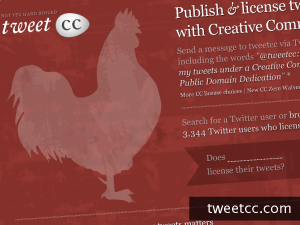
18:47 The other really interesting thing with this one is that the entire site is just built with alpha layered PNGs and the background, everytime you reload the website, the background colour changes. I think there is 4 or 5 different options. It's pretty fun, again it's these little delighters, you come back and it's a different colour, and you refresh to see what's next and because everything in between is just transparent PNGs, it's really easy to do. It's a bit of a hack.
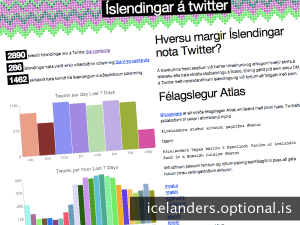
19:15 So that kinda lead me onto this next project. Which deals a lot with the Twitter API as well. Like i said, i live up in Iceland. iceland is great because there are two or three characters which aren't in the normal regular alphabet. So it is really easy to find icelanders on twitter. For those of you that don't know, there is about 300,000 people in the entire country. How many people live in Lisbon? The entire country of Iceland is probably smaller than the city of Lisbon. They have the highest per capita of cars, cell phones, nobel laureates, just because they're quite small. In doing so, they also have the highest density of facebook users, i think it is 46 or 48% of the nation is on facebook. I am not a huge fan of facebook, i like twitter a lot more. So i wanted to find out, how many people are on twitter? So i was crawling the twitter search API looking for a few key phrases and key which i knew were icelandic, if you are using this, you are probably icelandic and then just saving them to the database. So when I took this screen shot, we had about 3000 people, which is 1% of the nation is on twitter. And then we can start to do alsorts of cool stats, like which day is the most popular to post on, which hour is the most popular to post on alsorts of stuff like that. The other thing that i love, and the running theme here is going to be colours. The design at the top, the little knitting design, I generate this with the md5 hash. When ever you visit the webpage it takes the timestamp on the server, creates an md5 hash, looks at the first 6 characters and that's going to be a hex code and we generate a hex colour from that. I get three or four colours and then make a little design. Again, it is this generative art, every time you reload the page the design is ever so slightly different. Again, this is just another little one page hack. It has gotten alot of press, and alot of ideas and alot of things going. It might be interesting, i don't know, in portugues, if you tried to find a few keywords, it might be alot of brazilian portuguese as well. You might be able to find something that ONLY people in Lisbon talk about. Then you might start to build-up a database of local twitterers.
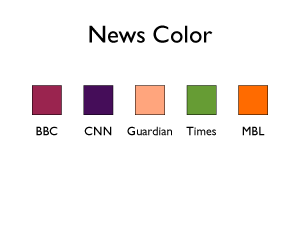
21:40 So that lead me onto this new project, I haven't gotten too far on this one, but it is an interesting on, so I want to bring it up. What i want to build for myself is a little dashboard. Every morning when I crank-up my web browser, I want 4 or 5 little colours of all the news sites. Each colour chip, like BBC is this pinkish-purple, CNN is purple, the guardian is this little flesh colour, the times is green and mbl is orange. The colours depend on the newspaper, if it is very positive or negative that day.
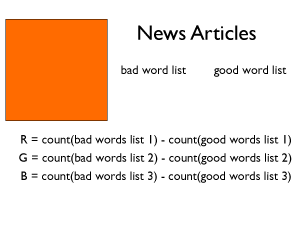
22:23 To do this, much like remy's idea, I have a list of bad words and a list of good words. All i am doing is editting the red values, the blue value or the green value based on this. I kinda built this and it was interesting, but to make it a really cool kinda hack, i took a page from the wikipedia guys idea. With wikipedia, you can edit any page on the site, but they started a new one. I think it is search.wikia I heard about this awhile ago, but haven't heard anything in a while, but they wanted to build a competitor to google, but they wanted the entire algorythm to be completely open. We don't know Google's secret sauce, maybe they weight headlines more, maybe they weight titles more, no one knows. What the wikiepdia guys want to do is make it completely open and anyone can edit the equation. As you look at the search results and say, what if we take the headline value of 2 and make it 2.5 and see what changes in the search results. It is a very democratic process for selecting the algorythm. So i wanted to build the same thing, I wanted to open this up to anybody and say, well what is the list of bad words and what is the list of good words, and anyone could add new ones or take some off. Maybe in the bad word list you might have terrorism, but everyone says that every 5 minutes now, so we'll give that a value of .1 but maybe a drougt or famine is a vey bad word, but not frequently used, we'll give that a value of 2 and the same for the good words, and we can turn that over to anyone to edit the equation as needed. Again, we can make the equation itself completely open so we can change the weights for how we get the counts for good and counts for bad. So i thought, ok this is cool, what can we use this for?

24:15 Two, three weeks ago now, Iceland had a meeting called þjoðfundur, what that translates into is "the national meeting". They got 1500 people from around iceland to come to a big sports arena and have a discussion about vision planning and where they wanted to take the nation. 1500 doesn't sound like alot, but that's half a percent of the entire country. I don't think you could get half a percent of portugal all in one place and discuss where you wanted to take the nation. As the meeting went on, they generated keywords, they said, "we want to be trustworthy", "we want independence", "we want education to be very high on the agenda", so everyone generated these texts. We thought what can we do with this, maybe this is the good list for our newspapers. Then each morning i could find out which newspaper was most inline with the nation's will. We pitched this at work and talked about it alittle bit. We decided that no matter which newspaper was good, there had to be a bad newspaper, and we didn't want to piss someone off, so we scrapped that idea of newspapers and said, well can we use this for anything else? Someone said, "what about politicians?"
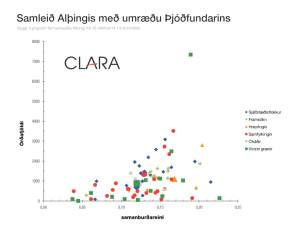
25:34 So we built this huge chart of all the politicians in iceland, because we have open data for all of the proceedings in the parliament, and we know who said what. We took all that data and we knew person number one said all these words and parse those out and see how many words were inline with the national meeting and how much of it overlapped. So we created a value on the overlap and then we created a value on how many words were spoken. Maybe someone said just 5 words, but every single one overlapped, and someone said 10,000 words and had more overlapping, but it was a smaller percentage. So we started generating this chart and you can see there's one person way up there who's said about twice as much as everyone else and he is also pretty well inline with the national meeting. then you've got somebody down here who's very hight correlation, but hasn't said much. It is very interesting to see where all the politicians fall into place. Maybe you could find your particular representative or your political party. So again, if you are looking for ideas for hack-day type things, you might be able to use multiple data-sets and do some really really interesting things.
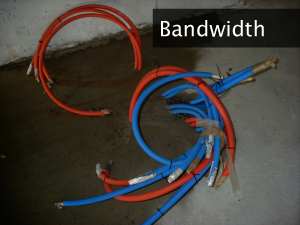
26:54 One of the themes for this conference is bandwidth. And i thought a lot about bandwidth recently, because I knew i was coming here and started thinking about it. As you get more and more bandwidth, as it increases, what are some of the things we can begin to do?

27:11 At work we have a huge problem of backing-up our database. it is several gigs large and it might take several hours to send it to someone like amazon. With infinite about of bandwidth or a really high amount of bandwidth is a backup schedule even necessary? If you can move 10 gigs of data in a second. Why are we scheduling a back-up, why not just do it every single time. And it got me thinking, that several years ago they were talking about when we moved from the command line or DOS prompt to the GUI, someone said, it is really ineffienct, you've gone from this command line to this huge 600 by 800 pixels. Some guys said, "Don't worry about it, we want to be wasteful." Wasteful is actually good. When you are in windows, there are alot of pixels and alot of memory just not doing anything, just lighting things-up. TO the purist, it is wasteful, but it has really taking computers from a commandline thing to a computer on every desk that your parents can use that non-tech savvy people use on a daily basis. So with bandwidth, we need to start thinking along these same lines to be wasteful of the bandwidth. And when we start thinking in those terms what kind of things fall out of this? From going from the command line to the GUI, from bandwidth to "what is that?". What is that going to be?
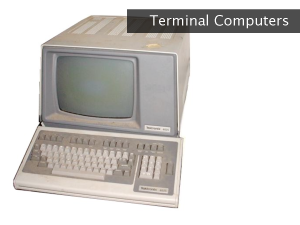
28:42 So i thought a little bit about this and we're really gone, in the history of computers from a thin client terminal to connecting to a main frame, because main frames are really expensive. To a personal computer in front of everybody. Now all of the horsepower and hard work is being done in front of you. But with infinite bandwidth, maybe it is time to flip this back around. if you look at your phone, it isn't a very Hefty duty computer, but it is always connected to the internet like a little window on something bigger. And maybe the computer can be the same thing. Up until now, it wasn't feasible to edit a 30 meg raw file in photoshop remotely because anything you did took forever. With infinite bandwidth it doesn't matter, pushing 30 megs back and forth to a server just takes a sec. Especially with cell phones picking-up this might be the way things are going to be moving with higher bandwidth.

29:43 The problem with bandwidth is not the bandwidth itself, but the transmission time. Latency. This is what we always forget about, because I grew-up with 14.4 modems, then 28.8, 56k, So the bottleneck was always the bandwidth. It didn't really matter the latency time, but now that we have faster and faster connections and I'm dealing with bigger and bigger websites, latency is becoming more of an issue. Some of the websites I worked on for bigger companies, having 300 millisecond ping times from california to iceland or Iceland to London. 300 milliseconds doesn't sound like a lot, but on the web world that's huge. So now that we've gotten the speed a lot faster, now we've got a new bottleneck of latency. The problem with latency is that we can't go faster than the speed of light. That's pretty much a given, we can't do that. So it's going to hit us a lot harder now and if we think about it, with the moon mission, when we sent the astronauts to the moon. No one really knows this, but there is a 2 or 3 second delay, not because of bandwidth, but because of the physical time it takes for a message to travel at the speed of light from earth to the moon and then the moon guys to hear it and send something back took between 2 and 3 seconds. And it's something that we forget about. So I was working on this idea with some friends.
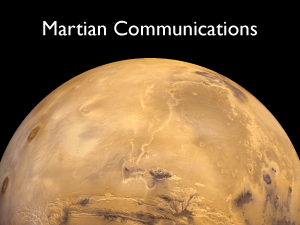
31:11 I can up with this, it is martian communications. I think you guys have already picked your hacks, if someone is looking for something to do, come talk to me because I have this brilliant idea. The US and the EU, i think, are quite keen on exploring mars and eventually try to send some astronauts there. But we forget that the latency time to send a message from earth to mars is about 15 minutes. So that means when I started this presentation, ... the framing of this idea is that, once you have astronauts there, say 3 or 4 astronauts are walking around, and one guy falls over and breaks his leg. You can't call 911 or 112, you do that and say "help, help, we've got an emergency" it is 15 minutes to get back to earth. So that means when I started this presentation, if someone got hurt, about the 15 minute mark earth would have heard it. Earth would say, "ok, here is what you've got to do. Set the leg, make sure... do all the stuff." Then it takes 15 minutes to get back to mars. That means at the 30 minute mark when I was in my presentation, mars finally gets the answer it wants. Mars might say, "Ok, that worked, but what do we do next?" That's 15 more minutes to get back to Earth. We're talking 45 minutes for just 2 bits of communication. So how do we overcome this, because it is impossible to overcome the speed of light! So I have been trying to work on ideas and one thing we can do, is come back to this idea of being wasteful. So maybe when Mars sends a message to Earth saying we're got an emergency, Earth doesn't send one message back saying, here's what to do, Earth sends a whole bunch of messages. Maybe it sends, "here's what you do first, if that works do this, if it doesn't work, do this." And build this huge binary tree of yes/no, yes/no, yes/no. We have infinite bandwidth, so why not send as much as possible. 99.9% of it is going to get thrown away and be wasteful, but it gets over this issue of latency. And then maybe every once and awhile Mars sends back what they've done and Earth can figure out where they are in this huge binary tree, throw away abunch and send stuff back. I am quite keen on exploring this more. There are other issues. YOu could put a man in the middle which kinda buffers messages, but i'm not sure many people are thinking about this as an issue both for latency of 15 minutes of communication back and forth.
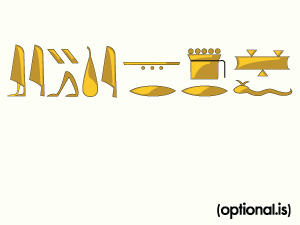
33:49 So finally here, does anybody know what these are? These are egyptian hieroglyphs, and i have a little story to tell you about this. Myself, remy, a friend josh and mike a couple of months ago, we went to the dconstruct conference, in Brighton in the UK. Had a good time, maybe too good of a time, because the next day we were all hanging out in the park, eating our icecream just relaxing, because that was about all we were capable of. Our friend mike pointed over to the museum and said "hey, that's a pretty good translation." and we were like, "Yeah, it says the Egyptian People, so what". He said, "no, no, no, the hieroglyphs, it says the Eyptians and the english is the Eyptian people. They did a really good job of capturing the translation." We all kinda looked at him for a sec there and were like hang on a sec, he can speak antient egyptian hieroglyphs, this is abit weird. My immediate thought is "t-shirt idea right here!".
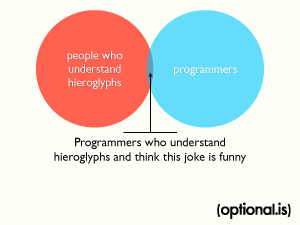
35:03 Here is a Venn Diagram. All the people who understand Egyptian Hieroglyphs, here's a Venn diagram of programmers, there's a tiny little sliver in the middle of people who both program and understand egyptian hieroglyphs. That is my target market for this t-shirt - not great.
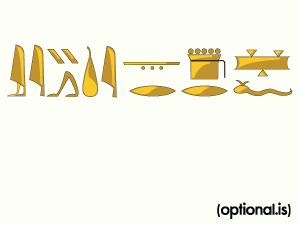
35:28 You know, do you every get that idea, when you start a crazy little project that you just said and all of a sudden I am getting emails from the London egyptology museum, and this guy with lots of letters behind his name and you say "oooo, i might have taken this joke a little too far." This is what we got back after several months of translation. And i am incredibly proud of this because as the egyptian culture was advancing a some point in time they would have invented computers. And when they invented computers, the first they would have to do is write a little program.
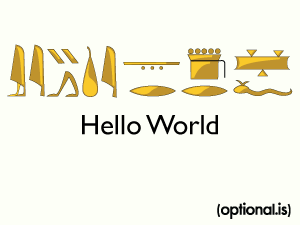
36:00 And when they wrote their program.... This is antient egyptian for "hello world". Now there is a few problems with this, first off, the major issue is that the egyptians didn't have the letter l. So we had to get the closest thing,
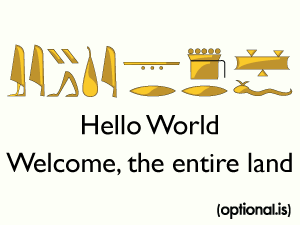
36:20 So we came-up with "welcome the entire land". Now this makes me really excited because the egyptologist who wrote me back said that this is quite possibly the first time this has EVER been written down. In 5000 years of hieroglyphs, this is the first time anyone has ever seen this. "Welcome the entire land." So as you guys go away these next couple of days and are working on some programs and learning new things, don't think "hello world", think "welcome the entire land"
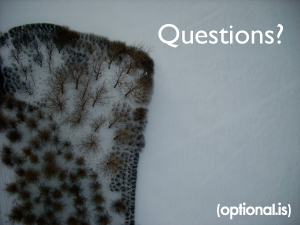
36:51 Thank you very much.
Downloads
- Download Slides [codebits.pdf (15.21 MB)]
Last modified: September 18, 2010 10:09:55 UTC
Copyright 2002-©-2025 Brian Sudahttp://suda.co.uk/publications/codebits/2009/transcript/